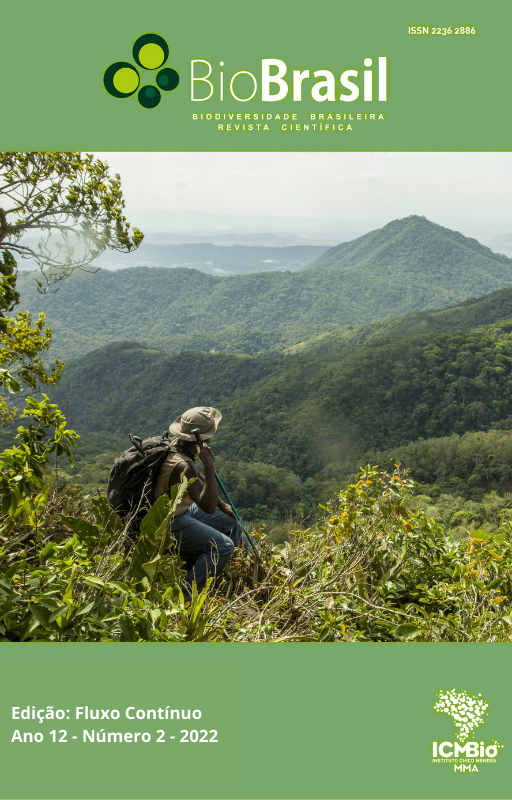Determination of the Diagnostic Leaflet for Nutritional Analysis in Ornamental Ginger Plants (Zingiber spectabile Griff)
DOI:
https://doi.org/10.37002/biodiversidadebrasileira.v12i2.2002Keywords:
Leaf analysis, diagnostic leaf, ornamental plantsAbstract
An efficient way to evaluate the nutritional state of plants is through monitoring following standardized leaf collection methods that represent their real nutritional state. It is necessary, the determination of the standard leaflet to be collected in sampling for foliar diagnosis of ornamental ginger, enabling evaluation of the nutritional state of the plant. Therefore, the objective of this study was to determine the standard collection leaflet for the evaluation of the nutritional state of ornamental ginger plants. The study was developed in the experimental field of ornamental plants of the Agrarian Sciences Institute of the Universidade Federal Rural da Amazônia, Belém/PA. The experimental design was randomized block design with 15 treatments (leaflets 1 to 15) and 4 repetitions. The contents of macro and micronutrients determined in the laboratory were submitted to multivariate statistical techniques of Principal Component Analysis and evaluated the similarity of treatments by Cluster Analysis. The leaflets 7, 8 and 12 were more representative of the nutritional state of the plant for micronutrient analysis, while for macronutrient analysis, leaflets 6 and 8 were more representative. Leaflet 8 can be used for joint analysis of macro- and micronutrients in a single sample collection.
References
Alvares CA, Stape JL, Sentelhas PC, Goncalves JLM, Sparovek G. Koppen’s climate classification map for Brazil. Meteorologische Zeitschrift, 22: 711-728, 2013. https://doi.org/10.1127/0941-2948/2013/0507
Amaral JFT, Bruckner CH, Martinez HEP, Cruz CD, Godoy CL, Caixeta SL. Determination of leaf sampling techniques to assess the nutritional status of Barbados cherry (Malpighia emarginata D.C.). Fruits, 57(3): 161-171, 2002.
https://doi.org/10.1051/fruits:2002015
Brasil EC, Cravo MS, Viégas IJM. 2020. Recomendações de calagem e adubação para o estado do Pará. 2ª ed. Brasília, DF: Embrapa. 419p.
Castro CEF, Castro ACR, Gonçalves C, Loges V. Morphophenological characterization of ornamental ginger and selection for landscape use. Hornamental Horticulture, 24(3): 255-260, 2018. https://doi.org/10.14295/oh.v24i3.1208
Coelho VAT, Dias GMG, Ferreira MM, Rodas CL, Silva MLS, Pasqual M.
Potassium and sodium mineral composition and growth in Zingiber spectabile plant. Revista Brasileira de Ciências Agrárias, 12(1): 35-40, 2017. https://doi.org/10.5039/agraria.v12i1a5417
Coelho VAT, Souza CG, Souza EN, Lacerda LG, Alves PC. Deficiência de micronutrientes e sódio em gengibre ornamental: variáveis de crescimento e composição mineral. Revista Multiverso, 5: e440, 2020.
Jones DT. 1993. Flora of Malaysia. Oxford University Press, Kuala Lumpur.
Kumar HP, Rakiappan P, Nair BP, Mohan E, Nagabhushanam S. Effect of season position and age of leaf on the major nutrient composition of cashew. Acta Horticulturae, 108: 291-293, 1985. https://doi.org/10.17660/ActaHortic.1985.108.62
Lima RLS, Ferreira GB, Weber OB, Cazetta JO. Part of plant to sample leaves for nutritional status evaluation in soursop (Annona muricata L.). Ciência & Agrotecnologia, 31(5): 1320-1325, 2007. https://doi.org/10.1590/S1413-70542007000500007
Lim TK. 2016. Edible Medicinal and Non-Medicinal Plants: Modified Stems, Roots, Bulbs. 12ª ed. Springer International Publishing Switzerland. 576p.
https://doi.org/10.1007/978-3-319-26065-5_22
Lins SRO, Coelho RSB. Ocorrência de doenças em plantas ornamentais tropicais no Estado de Pernambuco. Fitopatologia Brasileira, 29:332-335, 2004. https://doi.org/10.1590/S0100-41582004000300019
Lucena JJ. Methods of diagnosis of mineral nutrition of plants a critical review. Acta Horticulturae, 448: 179-192, 1997. https://doi.org/10.17660/ActaHortic.1997.448.28
Malavolta E. 2006. Manual of Plant Mineral Nutrition. Livro ceres, São Paulo, Brasil, 638p.
Marques DJ, Bianchini HC, Souza AP. Nitrogen fertilization on ornamental ginger under fertigation in protected cultivation. Horticultura Brasileira, 37: 146-151, 2019. http://dx.doi.org/10.1590/S0102-053620190204
Minitab 14. Statistical Software. [Software de computador]. State College, PA: Minitab, Inc. (www.minitab.com).
Mills HA, Jones JBJr. 1996. Plant analysis handbook II: a practical sampling, preparation, analysis, and interpretation guide. Athens, GA (EUA). 422p.
Raij BV. 2011. Fertilidade do solo e manejo de nutrientes. Piracicaba: International Plant Nutrition Institute, 420p.
Rozane DE, Natale W, Prado RM, Barbosa JC. Size of samples for nutritional status assessment of mango trees. Revista Brasileira Fruticultura, 29(2) 371-376, 2007. https://doi.org/10.1590/S0100-29452007000200035
Sadhu SK, Khatun A, Ohtsuki T, Ishibashi M. First isolation of sesquiterpenes and flavonoids from Zingiber spectabile and identification of zerumbone as the major cell growth inhibitory component. Natural Product Research, 21(14):1242-1247, 2007. https://doi.org/10.1080/14786410701371421
SiBCS. 2018. Sistema Brasileiro de Classificação do Solo. 5ª ed. Embrapa, Brasília, DF.
Silva FC. 2009. Manual de análises químicas de solos, plantas e fertilizantes. 2ª ed. Brasília-DF: Embrapa Informação Tecnológica. 627p.
Sirat HM, Leh NHN. The rhizome oil of Zingiber spectabile Valet. Journal of Essential Oil Research, 13:256-257, 2001. https://doi.org/10.1080/10412905.2001.9699687
Sivasothy Y, Awang K, Ibrahim H, Thong KL, Fitrah N, Koh XP, Tan LK. Chemical composition and antibacterial activities of essential oils from Zingiber spectabile Griff. Journal of Essential Oil Research, 24(3): 305-313, 2012. https://doi.org/10.1080/10412905.2012.676803
Soil Survey Staff. 2014. Keys to soil taxonomy. Washington, DC: US Gov. Print. Office.
Taiz L, Zeiger E, Møller IM, Murphy A. 2017. Plant physiology and development. 6ª ed. Oxford University Press.
Veloso CAC, Botelho SM, Viégas IJM, Rodrigues JELF. 2020. Amostragem e diagnose foliar. In: Brasil EC, Cravo MS, Viégas IJM. Recomendações de calagem e adubação para o estado do Pará. 2ª ed. Brasília, DF: Embrapa.
Viégas IJM, Lima SS, Lobato AKS, Silva SP, Conceição HEO, Silva DAS, Frazão DAC, Oliveira Neto CF, Cunha DC. Symptoms, growth, nutritional status and accumulation of nutrients in young Zingiber spectabile plants subjected to restriction of macronutrients. Journal of Food, Agriculture & Environment, 10 (2): 546-550, 2012. https://doi.org/10.1234/4.2012.3051
Zoghbi MDG, Andrade EH. Volatiles of the Etlingera elatior (Jack) R. M. Sm. and Zingiber spectabile Griff.: Two Zingiberaceae Cultivated in the Amazon. Journal of Essential Oil Research, 17(2):209-211, 2005. https://doi.org/10.1080/10412905.2005.9698878
Downloads
Published
Issue
Section
License
Copyright (c) 2022 Biodiversidade Brasileira - BioBrasil

This work is licensed under a Creative Commons Attribution-NonCommercial-NoDerivatives 4.0 International License.
Os artigos estão licenciados sob uma licença Creative Commons Atribuição-NãoComercial-SemDerivações 4.0 Internacional (CC BY-NC-ND 4.0). O acesso é livre e gratuito para download e leitura, ou seja, é permitido copiar e redistribuir o material em qualquer mídia ou formato.





 v3-3-0-3-2-1-8-release.27
v3-3-0-3-2-1-8-release.27